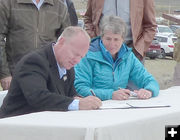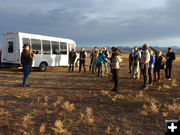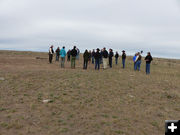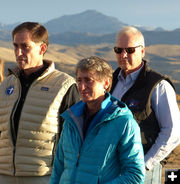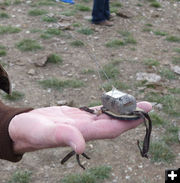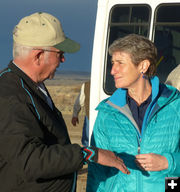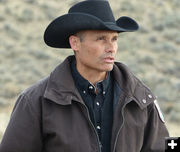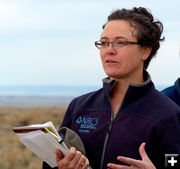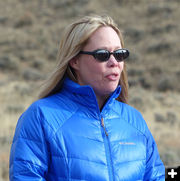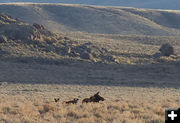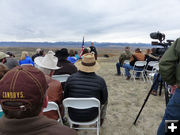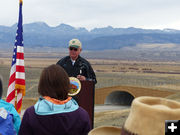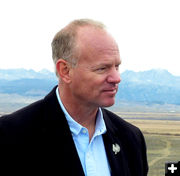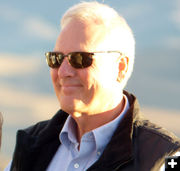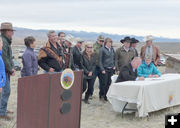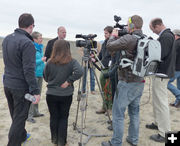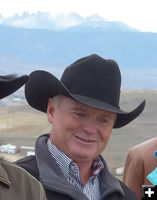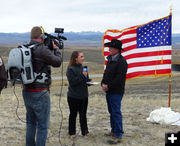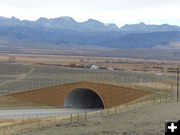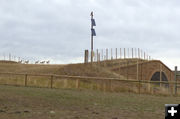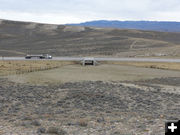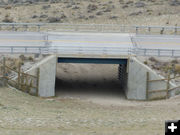
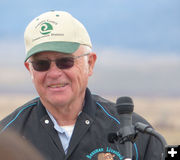
Rancher Brad Bousman
Bousman Livestock, Inc. His ranch has approximately 1,400 acres enrolled in the program. They worked with the Pilot Project for cheatgrass control, converted windmill windmill stock watering tanks to solar to eliminate perching by raptors, installed wildlife escape ramps in solar tanks, and for many years has actively implemented many conservation measures in his ranch practices.
|


Sally Jewell, DOI
"I'm optimistic we can preserve these ecosystems for the long-term future for ranching, oil & gas industry, and wildlife."
|

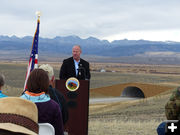
Governor Matt Mead
"These agreements we are signing today are really a chapter in wildlife history. Well-run ranches are great places for wildlife."
|

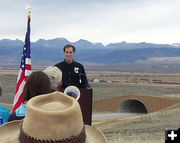
Dan Ashe
Director, U.S. Fish and Wildlife Service. "It is our hope that the listing of sage grouse under the Endangered Species Act will not be necessary."
|

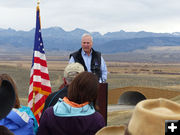
Don Simpson
Wyoming State Director, Bureau of Land Management. "Private landowners are a big key to managing sagegrouse habitat."
|

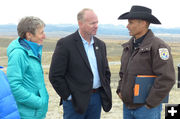
Coming together for sage grouse
Left to right: Sally Jewell, U.S. Secretary of the Interior; Wyoming Governor Matt Mead; Tyler Abbott, U.S. Fish and Wildlife Service.
|

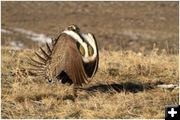
Sage Grouse
A male sage grouse strutting on a lek during mating season. File photo courtesy Sublette County Conservation District.
|

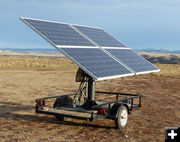
Solar Panel
Ranchers are voluntarily replacing old windmill water pumps which had been providing perches for sagegrouse eating raptors. The panels cost around $12,000 each.
|
|
Agencies and private landowners work together to protect sagebrush habitat
For sage-grouse and other wildlife species
by Dawn Ballou, Pinedale Online!
October 17, 2014
On Wednesday, October 15th dignitaries from across the state and nation gathered in Pinedale to celebrate a public-private partnership to sign nine agreements to conserve of sagebrush habitat to benefit sage-grouse and other wildlife species. The U.S. Fish and Wildlife Service, Bureau of Land Management, and the Sublette County Conservation District have been working with area ranchers for years to protect and conserve sagebrush habitat that is important for sage-grouse and many other species.
Sage-grouse are an important species to plan for because in 2015 U.W. Fish & Wildlife Service must make a decision about whether or not to list the bird on the Endangered Species list.
The event on October 15th included a morning tour of the Brad Bousman ranch near Boulder, and a signng ceremony at Trappers Point around noon. The ceremony involved the signing of nine agreements between the U.S. Fish and Wildlife Service and nine ranchers. The ranchers were recognized as the first landowners to enter into the U.S. Fish and Wildlife Services (FWS) Candidate Conservation Agreement with Assurances (CCAA) program for the greater sage-grouse in Wyoming.
Landowner stewardship of sage-grouse habitats is promoted through the CCAA, which provides private landowners with incentives for engaging in voluntary proactive conservation through assurances that limit future conservation obligations. Specifically, landowners are provided the assurance that if they implement various conservation measures, they will not be subject to additional restrictions if the species becomes listed under the ESA.
The days events were attended by U.S. Secretary of the Interior, Sally Jewell; Wyoming Governor Matt Mead; Dan Ashe, Director of the U.S. Fish and Wildlife Service; Don Simpson, Wyoming State Director of the Bureau of Land Management; Brad Bousman of Bousman Livvestock, Inc.; and many private landowners and local stakeholders.
Here is a list of the ranchers honored.
WYOMING CCAAs
Conservation practices
1. Brad Bousman - Bousman Livestock, Inc. (Sublette County)
Approximately 1,400 acres enrolled; all within Sage-Grouse Core Area
Involved with Pilot Project for cheatgrass control
Converted windmill stock watering tanks to solar to eliminate perching by ravens and other birds that preys on the eggs and young of sage-grouse.
Installed wildlife escape ramps in solar tanks that he manages both on private and public (BLM) lands.
Implemented (for many years) conservation practices such as flushing bars on his hay tractor to avoid and minimize collisions with sage-grouse that use his hay meadows; also delays haying until after the GSG nesting season.
Is an active Sublette County Conservation District Board Member and NRCS partner who supports the development and implementation of conservation programs for landowners.
Actively participates in monitoring GSG use on his BLM grazing allotments.
2. John Erramouspe - G & E Livestock, Inc. (Sublette County)
Approximately 1,200 acres enrolled; 97% in Sage-Grouse Core Area
Buries power lines
Uses solar power
Created overflow to provide access for sage-grouse, but limited use by livestock and wildlife
3. John Boroff - Boroff Land and Livestock (Sublette County)
Approximately 1,300 acres enrolled; 100% in Sage-Grouse Core Area
4. John Blaha - Blaha Ranch, Inc. (Sublette County)
Approximately 1500 acres enrolled; 100% in Sage-Grouse Core Area
5. Donald W. Rogers, Jr. (Sublette County)
Approximately 400 acres enrolled; 100% in Sage-Grouse Core Area
6. Fred Pape - Pape Ranches, Inc. (Sublette County)
Approximately 10,000 acres enrolled; 100% in Sage-Grouse Core Area
Philosophy that wildlife was there first, so they work with wildlife, and enjoy having wildlife on their property
Recipient of Regional Leopold Conservation Award in 2008
Worked with NRCS to create a mosaic patterned brush treatment to benefit sage-grouse
Promotes wildlife friendly fences where possible
Usually takes about 1.5 hours to cut a 10 acre area of oats. Last year there was about 20 sage-grouse in that area. Landowner walked through the oats to flush the birds out of the field before cutting. This extra effort took more than 4 hours to complete, but landowner didnt want to harm any sage-grouse.
7. Jennie & Mark Gordon - Merlin Ranch (Johnson County)
8,428 acres enrolled; 55% in Sage-Grouse Core Area
Family owned ranch established in 1988
Angus cattle ranch
Holistic management and cell grazing
Recipient of Excellence in Rangeland Stewardship Award 2009
Manager: Kevin Rodriguez
Owners: Mark and Jennie Gordon
8. Roy Liedtke, Kelly Hardy, Wendy Hutchinson- Longreach Buffalo Co., LLC (Campbell County)
3,240 acres enrolled; 100% in Sage-Grouse Core Area
The members of Longreach Buffalo Company, Kelly Hardy, Wendy Hutchinson, and Roy Liedtke, have spent their professional careers as caretakers of the environment. This dedication to the ecosystem is one reason they chose to diversify their ranch by raising buffalo, along with beef cattle, bringing this magnificent species back to its native range. The ranch is in NE Wyoming in core sage-grouse habitat, with a diverse mixture of rolling plains and timbered lands. The owners previous work in the coal industry allowed them to pool their resources and experience to purchase the ranch in 2001, where they have been a steadfast team devoted to creating a sustainable ranching environment for livestock and wildlife.
9. Priscilla Welles - HIP Investments, LLC (Johnson County)
12, 236 acres enrolled; 80% in Sage-Grouse Core Area
HIP Investments, run by the Welles family, is a cattle operation that runs on a contiguous swath of rolling prairie sagebrush country west of the Powder River Basin in NE Wyoming. The middle waters of Crazy Woman Creek run through its western border, and the ranch supports both riparian areas and prime sage grouse breeding and nesting grounds. A significant portion of the ranch lands lie in the recently described "core" area for supporting areas to be managed for sage-grouse habitat. This designation has helped the landowners re- affirm their historical dedication to running their livestock operation with a high regard for the safety and viability of the wildlife that share in the land's resources.
Initiatives that have been taken have involved: o Removal of woven wire fencing. Installation of fence markers to avoid bird collisions.
Buried power lines in areas of energy development.
Rotational grazing program utilizing recommendations and monitoring according to the Wyoming Rangeland Monitoring Guide.
Placement of stock watering tanks in upland areas to remove cattle from the riparian areas.
Bird escape ramps in all watering facilities.
Mosquito larvae application in rιservoirs to prevent the spread of west Nile Virus to bird populations.
Limited activity in pastures with lek areas during bird breeding season.
It is the goal of the land owners to have a healthy ecosystem through dedicated management for both the economic and ecological success of the operation.
|





